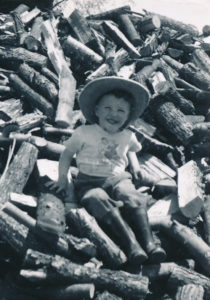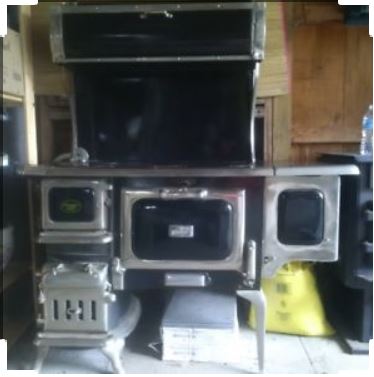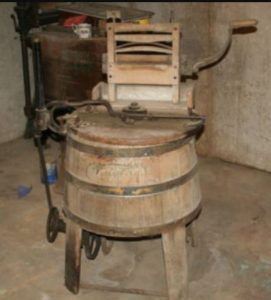The Back Kitchen and Woodshed
The Back Kitchen and Wood Shed
While going through some photos I found this photo of the ‘back kitchen and woodshed’ that was attached to the back of the house. I spent many hours piling wood in the woodshed and one of my ‘chores’ was to fill the woodbox in the house with wood from the woodshed. In addition to the ‘back door’, there was a sliding door that was left open in the summer to let the wind blow through. It move on a track and didn’t cover the back opening during the winter so the opening was closed up with piled wood.

The “back” kitchen and woodshed, c 1970 Winter Storm
The Woodshed
In the winter, Dad would go to the bush and do some management cutting in the maple bush and bring back a load of wood which would be piled in the yard near the woodshed. Different kinds of wood would be sorted into separate piles. Hardwoods for used for long burning night fires. Other types of wood were used for ‘quick or hot’ fires and cedar and ‘dead’ wood were set aside to use as ‘kindling’.
In the spring or early summer it would be cut into firewood lengths and left to dry in piles. Before the winter, the wood would be transferred to the woodshed where it was sorted according to how long it had dried. That was a Saturday job when all the kids could help!
It was never desirable to burn wood that had not dried for at least two years! Too much creosote would build up in the pipes and it would not burn ‘hot’. Much of the building in the photo was devoted to wood storage.
Oh how we loved finding the pieces with birch bark still attached! We would carefully remove it and try and peel the layers apart.

Dad would ‘stoke’ the fire before leaving for Church Sunday Morning

John on the Woodpile c1952. The piles of wood were large and would sit like this until fall or sometimes until the next year!
The Back Kitchen
The Stove

The Stove in the back kitchen was similar to this but ‘rusty’ from only seasonal use.
In the section, adjacent to the worker house addition was a raised platform with plank floor. A wood stove was located here for summer use. Water had to be heated for laundry in a large copper boiler or two. Homemade soap was made in large cast iron pots that would fit into the holes in the stovetop when a ‘lid’ was removed. Large pots of preserves were cooked here as well. All this to keep the heat out of the house!
The Washing Machine
In the summer the wringer washing machine would be moved from the utility/laundry room and located here. When the washer was used, two square tubs would be set on a folding stand and filled with water for rinsing the clothes. Clothes would be put through the wringer when they came out of the washer and again each time the were rinsed in one of the tubs before being hung on the clothes line to dry.
Homemade soap was dissolved in hot water on the stove while the the water was heating and added to the wash water as needed. The washer water was used for multiple loads – whites first, the coloured, the work clothes. Can you imagine what it was like to have one or two children in diapers?
The washing machine used prior to the installation of electric power still sat in a corner behind a door.

A washing machine like this was stashed in a corner of the summer kitchen and was used until hydro was installed about 1948.

This Wringer Washer is similar to the one I learned to use as a child. I was warned about the dangers of the wringer.
On the Walls
As I look around the back kitchen in my minds eye, I remember the table in one corner. In the winter it became a ‘catch all’ but also served as a ‘house tool bench’ where minor repairs would be made. It also served as an area where mason jars were stored when emptied, ready for sterilization and use the following summer.
Mounted on the walls were, snowshoes, skis, Dad’s shotgun, 22 caliber rifle and other seasonal items. A couple of hand ‘wash boards’ were mounted for quick access if needed during laundry.
On one wall were two ‘rag bags’ – one for cottons and one for wools. We would go to the ‘cotton’ bag when we needed a cloth for Saturday dusting and cleaning chores. Each spring we would have a visit from a peddler who would collect the rags for recycling and pay a small amount for them. Later there were groups formed and the rags would be collectively gathered and collected by a representative of a firm in Montreal that would weigh each person’s collection return them as woolen ‘car’ blankets or woven rag rugs according to the poundage submitted.
The Sink
In the corner by the woodshed was a built-in ‘sink’ with aged mirror above. In the sink was a basin used to hold water for the men to wash before meals. Water for ‘washing up’ was taken from a rain barrel set outside the door by the corner of the house and kept in a pail by the sink.
The water in the basin would be saved in a pail under the sink (no plumbing)and later used to water flowers and other plants near the house. Plumbing was difficult because the house was built on a solid sandstone plateau. (See note on basement in previous post).
The Woodshed Attic
Dad had a saying oft quoted “If you keep something for seven years, you will find a use for it,” As we got older we often teased him that the seven years were up. His response was that “Well let’s try for another seven years.”
As children we were not allowed to climb the steep stairs to the attic unaccompanied as there were gaps in the planks that formed the floor and the floor sagged significantly in several places. But what a treasure house that was! Old family photos in frames, furniture, yarn winders and a multitude of other items set aside by the family in years past.
In the years after my marriage I was the recipient of a number of items that Dad refurbished and gave to me. Each of the children received a number of items. Unfortunately many of the items I received were large in scale and when we made the decision to put our belongings in storage I had to find a new home for them. Many items were donated to local museums and what they could not use were sold to local antique dealers.

Another interesting article Diane!
I love reading your articles including the old photos.
My family stories based on research of family members further back are developing in the background. I’ve joined a couple of on-line challenges and they are all stressing the importance of starting with ‘your’ story. It will be a legacy for my kids and granddaughter.